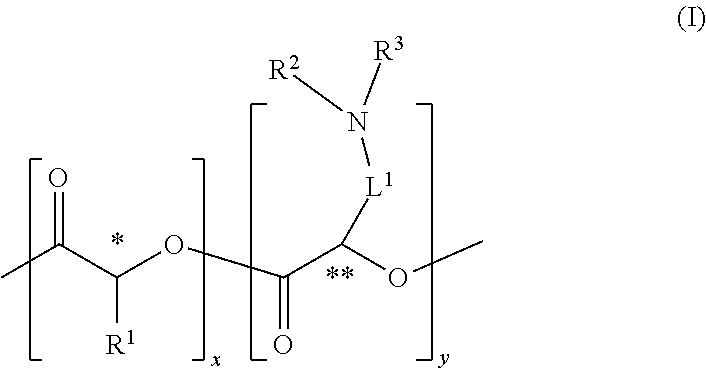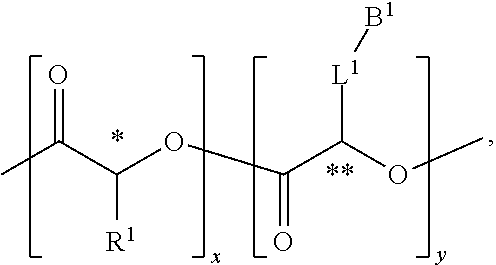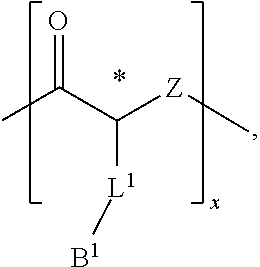Cationic Polymers
a cationic polymer and polymer technology, applied in the direction of transferases, peptide/protein ingredients, genetic material ingredients, etc., can solve the problems of challenging nucleic acid delivery as therapeutics, and achieve the effects of improving the in vivo delivery of therapeutic nucleic acids, potent and/or safer nucleic acid delivery, and safe and efficient nucleic acid delivery
- Summary
- Abstract
- Description
- Claims
- Application Information
AI Technical Summary
Benefits of technology
Problems solved by technology
Method used
Image
Examples
example 1
of Compound 3.13 (PCMMA Monomer)
Synthesis of 3.2
[0344]To a solution of 3.1 (25 g, 210 mmol) and K2CO3 (83 g, 601 mmol) in water (125 mL) cooled in ice-water bath was dropped in a solution of di-cert-butyl Bicarbonate (50 g, 229 mmol) in 1,4-dioxane (80 mL). After the addition was complete, the reaction mixture was allowed to slowly attain room temperature and was stirred for 48 h. The reaction mixture was extracted with diethyl ether (70 mL×2). The aqueous layer was acidified with 6N HCl to pH=4 and then extracted with ethyl acetate (600 mL×4). The combined organic extracts were washed with brine (800 mL), dried over Na2SO4 and filtered. The filtrate was evaporated to give 42.5 g (92%) of product 3.2 as slightly yellow oil.
Synthesis of 3.3
[0345]To a stirred mixture of 3.2 (30 g, 137 mmol) and K2CO3 (56.7 g, 411 mmol) in DMF (200 mL) at room temperature was added methyl iodide (25.6 mL, 4.11 mmol) through a syringe. The resulting mixture was stirred at room temperature under nitrogen...
example 2
of PCMMA-Boc Copolymers
Synthesis of PCMMA-BOC
[0355]To a solution of 3.13 (300 mg, 0.78 mmol) in anhydrous DCM (1 mL) and anhydrous benzene (2 mL) in an oven-dried Schlenk tube equipped with a magnetic stirring bar under nitrogen atmosphere was added a 0.1 M solution of Sn(2-ethylhexanoate)2 in anhydrous benzene (13 μL, 0.0039 mmol) and 0.1 M solution of 4-tert-butylbenzyl alcohol in anhydrous benzene (13 μL, 0.0039 mmol). The resulting solution was degassed three times using Freeze-Pump-Thaw method. The solvents were removed under reduced pressure. The Schlenk tube was filled with nitrogen, sealed and immersed in an oil bath (110° C.). After stirring for 72 h at 110° C., the reaction mixture was cooled to room temperature and dissolved in anhydrous dichloromethane. The result dichloromethane solution was concentrated in vacuo to give 289 mg of crude copolymer (WSM-641-123C). The crude polymer was dissolved in 1,2-dichloroethane and loaded onto Sephadex LH-20 column and eluted with 1...
example 3
ion of PCMMA-Boc
[0359]A solution of PCMMA-BOC (250 mg) in anhydrous dichloromethane (2.5 mL) and trifluoroacetic acid (2.5 mL) was stirred at room temperature for one hour. The reaction mixture was concentrated under reduced pressure. The residue was dried under high vacuum to give 245 mg of crude PCMMA. The crude copolymer was dissolved in anhydrous dichloromethane (1.5 mL) and dropped into diethyl ether (60 mL). The precipitate was washed with diethyl ether (60 mL) and dried under high vacuum to give 171 mg of Target PCMMA as off-white foam. GPC characterization data is provided in Table 7.
TABLE 7ExampleMpMnMwMzPDI3.168295115728599131.42
PUM
| Property | Measurement | Unit |
|---|---|---|
| MW | aaaaa | aaaaa |
| MW | aaaaa | aaaaa |
| MW | aaaaa | aaaaa |
Abstract
Description
Claims
Application Information
 Login to View More
Login to View More - R&D
- Intellectual Property
- Life Sciences
- Materials
- Tech Scout
- Unparalleled Data Quality
- Higher Quality Content
- 60% Fewer Hallucinations
Browse by: Latest US Patents, China's latest patents, Technical Efficacy Thesaurus, Application Domain, Technology Topic, Popular Technical Reports.
© 2025 PatSnap. All rights reserved.Legal|Privacy policy|Modern Slavery Act Transparency Statement|Sitemap|About US| Contact US: help@patsnap.com



